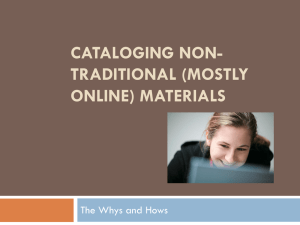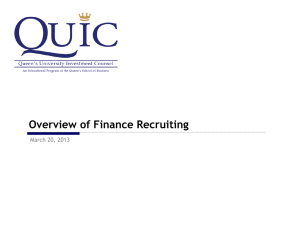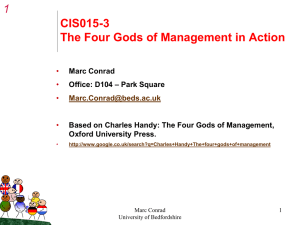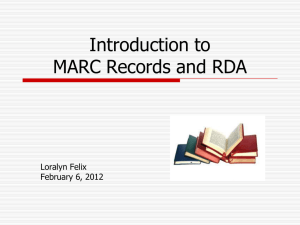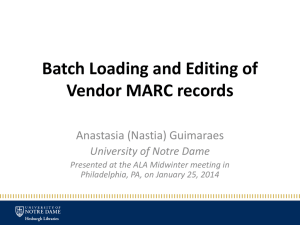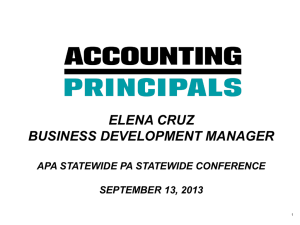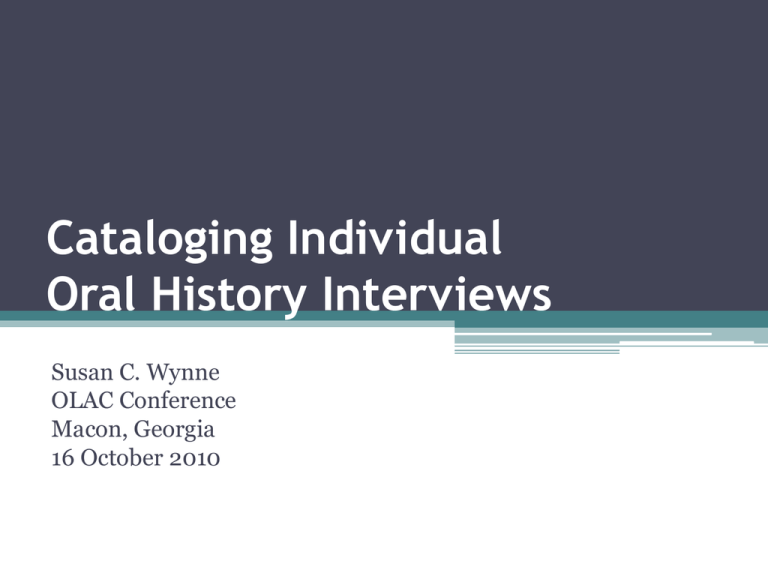
Cataloging Individual
Oral History Interviews
Susan C. Wynne
OLAC Conference
Macon, Georgia
16 October 2010
Outline
• Definition and importance of oral history
• Summary of cataloging issues from 2007 survey
of Georgia academic libraries
• Description of CSU project
• Cataloging decisions/considerations
• Creating MARC records for individual
interviews
• Exercise
What is oral history?
“The process of deliberately eliciting and
preserving, usually in audio or audio and
visual recording media, a person’s spoken
recollections of events and experiences
based on first-hand knowledge.”
Oral History Cataloging Manual
Another definition
“A process of collecting, usually by means of a
tape-recorded interview, recollections,
accounts, and personal experience narratives of
individuals for the purpose of expanding the
historical record of a place, event, person, or
cultural group.”
Smithsonian Center for Folklife and Cultural
Heritage
And another…
“Oral history is the recording, preservation and
interpretation of historical information, based
on the personal experiences and opinions of the
speaker.”
Wikipedia, 23 August 2010.
Oral history interview
• Covers subject(s) of historical interest
• Conducted by an interviewer who has some
understanding of the subject(s)
• Knowledgeable interviewee
• Interactive
• Question and answer format
• Intended to be available to researchers
Oral history project
“Series of oral history interviews focused on
documenting a topic, theme, era, place,
organization, event, or group of people,
conducted according to a plan, usually under the
auspices of an institution or a group of
cooperating institutions.”
OHCM
Oral history collection
“Oral history materials from various
interviews not associated with an oral history
project, usually assembled at some time after
their creation by an individual collector, or by
a repository for convenience in management
or description. A collection, like an oral
history project, often has an identifiable
theme or focus.”
OHCM
Why is oral history important?
• Fills gaps in the historical record
• Supplements and aids in understanding the
historical record
• Often preserves viewpoints or experiences of
underrepresented groups
• May document everyday life or give behind-thescenes perspective on a well known event, person,
organization, etc.
• Connects personal experiences with history and
social context
• Catalogers may be shifting local expertise to unique
or hidden collections
Why are oral histories difficult to
catalog?
• Lack of consensus in access methods
• Standard manual needs updating
• “Neither fish nor fowl” … are they more like
archival or published materials?
• Multiple formats
• Names and organizations often require some
authority work
• Often no dedicated staff or funding for managing
access to oral histories
• May be little or no accompanying information
Choice of cataloging methods
•
•
•
•
•
•
MARC records in local catalog and/or WorldCat
Finding aids (online and/or print)
Inventory
In-house
Digital library
Non-MARC metadata (e.g., Dublin Core)
Benefits of the MARC approach
• No need to consult a separate resource to
discover oral history materials
• Navigate between oral histories and other types
of material on the same subjects
• Contributing to WorldCat is one way to share
beyond the local institution
• Less of a learning curve if staff are already
familiar with MARC
Grimsley and Wynne’s 2007 survey
•
•
•
•
•
31 Georgia academic institutions
Access issues related to oral histories
Methods of intellectual access vary
Respondents held variety of formats
Only one respondent (CSU) reported using
OHCM
• Few respondents reported applying authority
control to subjects and names related to oral
histories [caveat]
Methods of intellectual access in GA
academic libraries
10
9
8
7
6
5
4
3
2
1
0
Small
Medium
Large
Total
Full
MARC
Brief MARC Print
Web
MARC in OCLC Finding Finding
Aid
Aid
None
Other
Cataloging standards/procedures
Standard/procedure
Oral History Cataloging Manual
1
Anglo-American Cataloguing Rules, 2nd ed. (AACR2)
6
Archives, Personal Papers, and Manuscripts (APPM)
0
Describing Archives: A Content Standard (DACS)
3
Dublin Core
0
Other Metadata
1
Local Procedures
4
Other
1
No Answer
8
Columbus State University’s project
(or, How did I get myself into this?)
• Project initiated by former archivist Reagan
Grimsley
• ~500 oral histories lacking intellectual access except
for rudimentary in-house finding aid
• Many typescripts and analog recordings from the
1970s and 1980s
• Collaboration between archivist and cataloger
• New acquisitions and cataloging policies
• Grant to digitize selected typescripts
• Collective finding aids and MARC records for
selected individual interviews
CSU’s workflow
• Archives staff copy typescript onto acid-free
paper and create artificial title page for each
typescript
• Periodicals Assistant prepares photocopied
typescript for binding
• Cataloger creates MARC record using OCLC
Connexion Client, exports record from OCLC
into ILS, and creates holdings (for copied
typescripts only)
• Cataloging Assistant creates item record and
performs minimal physical processing on bound
typescript
Cataloging considerations (top-level)
•
•
•
•
Staffing
Priority level
Size of collection/backlog
Transcripts
Cataloging considerations
• Unit of description
• Format(s) to be described (especially which
format(s) are available for use)
• “Readily available” information
• Level of authority control
• Classification
• Choice of cataloging method (not discussed in
depth here)
Unit of description
• Collection level
• Project level
• Individual
Collective vs. individual descriptions
Collective (Project or
Collection Level)
• Required according to OHCM
• Oral histories typically
collected in groups
• Consistent with archival
principle of provenance
• Demonstrates shared focus
and characteristics within the
group
• Useful when interviews are
more meaningful as a group
• No need to repeat information
in multiple individual records
Individual (Item level)
•
•
•
•
Optional according to OHCM
More granular access
More time-consuming
Need a mechanism for
demonstrating relationships
• Useful when interviews may be
able to stand alone
• Useful when information
about the collection/project is
scarce
You can always do both and
link from one to the other
Formats to be described
• Rule: describe the format(s) available for use
• Optionally, also describe original recordings
“Readily available” information
• Which pieces of information are most
important?
• How much time can you spend in research?
• Consider your users, priorities, staffing, and
possibly the context of each interview
Authority control
• Contribute records to OCLC authority file
(NACO participants)
• Create records in local system (always, or only in
special cases)
• Construct AACR2 (or RDA?!) headings but do
not create authority records
• Use LCSH or another controlled vocabulary
• Create a specialized vocabulary
• Uncontrolled keyword
Classification possibilities
• Biographies
• Local history
• Subject of the interview (i.e., textile mills, school
desegregation)
• Accession number or other local system
• Class interviews in a project together
• Others?
Crash course in oral histories for
catalogers
• Context is more important
• Less emphasis on transcribing information from
the item into the record—most information is
provided by the cataloger
• Obtain information from the typescript and/or
recording itself, finding aids, release forms,
labels, and any accompanying material
• External reference sources can be helpful and
sometimes necessary (to clarify names, events,
locations, etc.)
• Copious notes
OHCM’s fundamental elements for
individual interviews
Indication of form (i.e., oral history interview)
Name(s) of interviewee(s)
Date(s) of interview
Statement of quantity or extent, including
physical format
• Name(s) of interviewer(s)
•
•
•
•
OHCM’s fundamental elements for
individual interviews
• Language of interview, if other than English
• Summary of the nature, content, and scope of
the interview
• Restrictions on access and/or use, if applicable
• Name of the project or collection, if applicable
If any of these fundamental elements is not
available, state in a note that it is missing
2-minute version of this presentation
• Who … interviewee(s) & biographical sketch,
interviewer(s), persons or groups that are
subjects of the interview
• What … oral history interview, format(s)
• When … date(s) involved, time periods discussed
• Where … place(s) discussed in interview,
location of interview
• Why … project or collection name, subjects
discussed, summary
Walk through a MARC record for an
individual interview
Type code (Leader/06)
Varies according to the format(s) you are
describing
• p (mixed materials) for multiple formats
• i (nonmusical sound recording) for audio only
• g (projected media) for video only
• t (manuscript language material) for
unpublished typescript/transcript only
BLvl code
• Depends on unit of description
• Cannot use BLvl “m” with mixed materials
workform
• Use “c” with mixed materials workform or for
collective description
• Use “m” when describing one format only
Other fixed fields
•
•
•
•
•
Country code = xxu (unpublished, United States)
Add 006 for each format as needed
Add 007 for each format as needed
Ctrl = a (archival control)
DtSt = usually s (single date) for individual
interviews, could be i (inclusive dates) for
interviews, projects, or collections spanning
different dates
006 and 007 examples
006 for typescript: t
000 0
006 for sound recording: innn
t
007 for sound recording (standard cassette):
s $b s $d l $e u $f n $g j $h l $i c $j u $k p $l
n $m u $n e
Main entry (MARC 1XX or 245)
• Interviewee (MARC 100)
• If multiple interviewees, use the predominant
interviewee (or title)
• Use relator terms in $e
100 1_ $a Perry, Ophelia S., $e interviewee.
Title (MARC 245)
•
•
•
•
Form element
Name(s) element
Date(s) element
GMD not used unless describing only one
format: electronic resource, microform, sound
recording, or videorecording
245 10 $a Oral history interview with
Ophelia S. Perry, $f 1988 Feb. 23.
Statement of responsibility (MARC 245 $c)
• OHCM omits statement of responsibility
• Rule: give responsibility information in notes
• CSU decided to add SOR:
/ $c conducted by Harvey Phelps.
Edition statement (MARC 250)
• Do not give an edition statement
• If the interview exists in multiple versions (e.g.,
edited transcript), give this information in a note
500 $a Transcript heavily edited.
Publication information (MARC 260)
• Do not provide a publication statement for
unpublished oral histories
• Date appears in 245 $f
Physical description (MARC 300)
• Describe formats available for use (optionally, may
also describe original format)
• Multiple MARC 300 fields if applicable
• Use $3 with multiple 300 fields to specify the
material
• Required: specific material designation and number
of units
• Optional: playing time, type of recording (analog or
digital), playing speed, dimensions
• Playing time is usually not readily available for
CSU’s holdings
Physical description examples
300 __ $3 Typescript: $a 13 leaves, bound ;
$c 29 cm.
300 __ $3 Sound recording: $a 1 sound
cassette : $b analog.
Series statements
• OHCM: Concept of series does not apply to oral
histories
• CSU uses series statements as one means to
collocate projects and collections in the absence
of collective descriptions
• CSU also collocates the entire oral history
collection with a series statement
Series statement examples
830 _0 $a Mill worker oral history
collection
830 _0 $a Columbus State
University oral history collection
Minimum required notes in OHCM
• Interview details (MARC 518)
• Scope/content/abstract (MARC 520)
Interview details (MARC 518)
Required:
Date(s) of interview
Name of interviewer
Language (if other than English)
Optional:
Location of interview
Names of any other persons present
Sponsorship (if applicable)
Any other circumstances surrounding the
interview
Interview details example
518 __ $a Interview conducted by Harvey
Phelps in Columbus, Ga., for the Mill
Worker Oral History Project, 23 February
1988.
Scope/Content/Abstract (MARC 520)
•
•
•
•
•
•
•
•
Topics, conditions, issues, etc.
Events, activities, etc.
Places or geographic areas
People
Organizations
Time periods
Opinions/attitudes of interviewee
Summary of stories/anecdotes
Scope/content/abstract example
520 __ $a Ophelia Perry discusses
working conditions, wages, labormanagement relations, race relations,
benefits, and women’s jobs, in the Bibb
Manufacturing Company mill during
World War II through the 1970s.
Biographical information about
interviewee (MARC 545)
• Birthplace
• Education
• Race, ethnicity, nationality
• Family information
• Occupation(s)
• Political/religious/other affiliations
• Accomplishments
• Other…
Biographical sketch example
545 __ $a Ophelia Perry, who was born in
Harris County, Ga. and moved to
Columbus, Ga., during the Depression,
worked in the Bibb Manufacturing
Company mill from 1940 to the 1970s.
Other notes
• Additional physical form available (MARC 530)
for digitized typescripts
• Restrictions on access (MARC 506)
• Terms for use and reproduction (MARC 540)
• Reproduction, if applicable (MARC 533)
Other notes
•
•
•
•
•
Location of originals or duplicates (MARC 535)
Provenance (MARC 561)
Immediate source of acquisition (MARC 541)
Finding aids (MARC 555)
Citation (MARC 510)—refer to other works that
index, describe, cite, etc. the interview(s)
• Preferred form of citation (MARC 524)—of the
interview(s) themselves
• Publications (MARC 581)—cite works based on
the interview(s)
Other notes
•
•
•
•
•
Supplementary materials
Relationships to other materials
Missing information
Transcripts—versions, editing, etc.
Any other information deemed important not
covered by other notes
Sound recording is housed in the Manuscript
Collection at call no. MC 109.
Notes examples
506 __ $a Available for use only in the
Columbus State University Archives Reading
Room.
540 __ $a Permission to publish material
from the Columbus State University Oral
History Collection must be obtained from the
Columbus State University Archives.
555 0_ $a Finding aid available in the
Columbus State University Archives and
online.
Notes examples
541 1_ $c Gift; $a John Smith, $b Columbus
State University History Department, $d
1988.
524 __ $a Oral history interview with Ophelia
S. Perry, 1988 Feb. 23, Columbus State
University Archives, Columbus, Georgia.
(524 __ $a [Title of interview], [date of interview],
Columbus State University Archives, Columbus,
Georgia.)
Access points for individual interviews
• Additional interviewees other than the main
entry—use relator term $e interviewee (MARC
700)
• Interviewer(s)—use relator term $e interviewer
(MARC 700)
• Name of the oral history project (MARC 710)
• Any corporate bodies associated with the
interview, project, or collection (MARC 710)
• Alternate titles (e.g., title supplied by the
interviewer or transcriber) (MARC 246)
Access points examples
700 1_ $a Phelps, Harvey, $e interviewer.
710 2_ $a Mill Worker Oral History
Project.
246 1_ $i Caption title on typescript: $a
Beeler Haines interview
Subject access
• Not covered by OHCM, AACR2, DACS … will be
covered in RDA later?
• Name of interviewee(s) with $v Interviews.
(MARC 600)
• Names of other people that are prominent subjects
of the interview
• Organizations or corporate bodies that are
prominent subjects in the interview (MARC 610)
• Geographic headings for places discussed (MARC
651)
• Topical headings for subjects discussed (MARC 650)
• Classes of people or ethnic groups, as applicable
• Title or name-title entries for named works that are
subjects of the interview
Subject access
• LCSH may not be specific enough for specialized
collections
• Subject-specific thesaurus
• Locally developed thesaurus
Subject access examples
600 10 $a Perry, Ophelia S. $v Interviews.
610 20 $a Bibb Manufacturing Company $x History.
610 20 $a Bibb Manufacturing Company $x
Employees.
650 _0 $a Cotton textile industry $z Georgia $z Bibb
City $x History.
650 _0 $a Women textile workers $z Georgia $z Bibb
City $v Interviews.
650 _0 $a African Americans $z Georgia $z Bibb City
$v Interviews.
651 _0 $a Bibb City (Ga.) $x History $y 20th century.
Genre/form access
• Library of Congress Genre/Form Terms for
Library and Archival Materials
655 _7 Oral histories. $2 lcgft
(practice to be implemented late 2010/early
2011?)
• Art & Architecture Thesaurus
655 _7 Oral histories. $2 aat
655 _7 Transcripts. $2 aat
Links to online content, when
applicable (MARC 856)
• Digital version of typescript, audio, video, etc.
856 41 $3 Typescript $u
http://archives.colstate.edu/oral_history
/OpheliaPerry-OralHistory.pdf
• Finding aid(s)
856 42 $3 Finding aid $u
http://archives.colstate.edu/findingaids/
mc109.php
Linking collective and individual
descriptions (MARC 773)
• Only if creating BOTH collective and individual
description
• Use “Forms part of”
• Give project or collection title (created according
to guidelines for project or collection titles)
773 08 $i Forms part of: $a Mill Worker
Oral History Project.
Record examples
• Connexion browser http://connexion.oclc.org/
• CSU catalog https://gil.colstate.edu/
Exercise
• Frank Brown interview
Were rules meant to be broken?
• Do consider the unique needs of your users and
your collections (and your staffing/workflow)
• MARC records unlikely to be used for traditional
copy cataloging, but…
• You may be crosswalking them into non-MARC
metadata
• … which may be harvested by other institutions
• … and repackaged in unexpected ways
• How does your data look outside the catalog,
and outside of your institution? (“On a horse”)
Advice
• Standardize what you can (title format,
006/007/300 for common format(s), selected
notes, genre/form headings, etc.)
• Use constant data, templates, macros, text
strings, etc. when you can
• Document decisions—choice of thesaurus or
classification scheme, deviations from
guidelines, etc.
• Provide context in notes
Collaboration between catalogers,
archivists, oral historians
“All my investigations point to the information
gap between the creators of oral histories and
those who care for them. The need for
standards, best practices, and a spirit of
collaboration is essential … to ensure that the
work of oral historians is preserved as part of
our cultural heritage.”
--Nancy MacKay, Curating Oral Histories: From
Interview to Archive (Walnut Creek, Calif.: Left
Coast Press, 2007), preface.
Awareness of non-cataloging issues
(which may affect cataloging)
•
•
•
•
•
•
•
•
Ownership
Consent forms
Preservation
Format refreshment or transfer
Restrictions on access
Transcription
Technology
Acquisitions and collecting policies
Information forms
•
•
•
•
•
•
•
•
•
Names of interviewee(s) and interviewer(s)
Date(s) and location(s) of interview
Summary of content
Biographical information about interviewee
Subject keywords or places, topics, events, etc.
discussed
Name of oral history project, program, etc.
Sponsoring institution
Access restrictions
Playing time of recordings
RDA and oral histories?
• Glossary and 6.9.1.3 Recording content type
• Content (MARC 336), Media (MARC 337),
Carrier (MARC 338)
• Content type “spoken word” includes oral
histories
• Relationships
• Interviewee and interviewer are relationship
designators for creators (work-level
relationship)
Questions?
Contact me
Susan Wynne
University of Wyoming
307-766-2433
swynne@uwyo.edu

